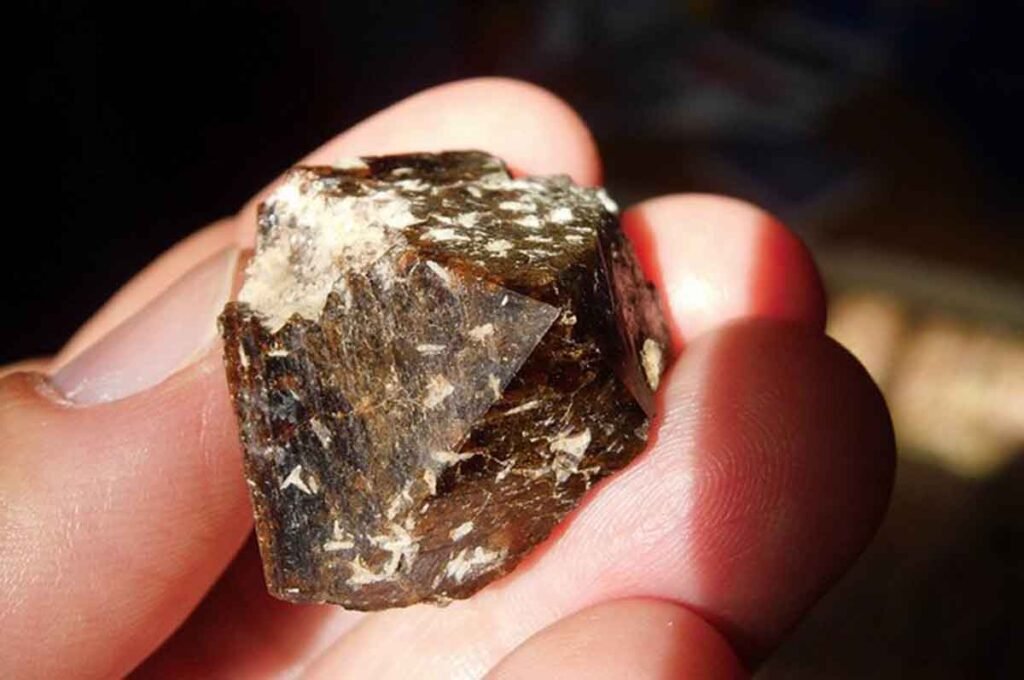To make a statement,” answered a young girl when asked of the blazing tattoo on her upper right arm. Can’t blame her. In one way or another, we all want to make a statement. If you do, here’s one that is cool, chic, and classy—a great way to wear jewelry—get one of the top brown gemstones.
“Brown gemstones? Are there any brown gemstones, and what gemstone is brown in color, or what are brown crystals called?”, you may wonder.
Yes, there are and this article is about them. So read on so you will know what you need to know about these stones—the latest craze in the jewelry world.
But first things first…
The Top Brown Gemstones
What gemstone is brown in color? Actually, there are many gemstones that are brown in color. And in the world of gemology, there are a variety of brown crystal names—minerals diluted with other minerals such as bronzite, sardonyx, obsidian, etc., that give them varying hues of brown. It can be opaque or translucent. A brown gemstone is not always just a brown rock.
The words “rocks” and “gemstones” are often used interchangeably. It might make you ask, “what kind of rocks are brown?” Brown is the color of Earth and there are thousands of brown rocks. Just by looking at the color is not the best method for brown gemstone identification against a common brown rock. It needs a trained person to do that.
And why would they make good “statements?”
Google defines “making a statement” as “creating a certain impression, communicate an idea or mood without using words.” Or “to show people what you think, or believe by behaving in a particular way.”
As a color, brown symbolizes strength, reliability, and dependability. It’s no accident that UPS, M&M, Gloria Jean’s Coffee, and many others use brown as their company color – that’s their brand statement.
As a gemstone, brown was out there in the field. Nobody paid attention to it. People consider them dull, and unattractive. They weren’t worth a second look.
Until celebrities became fond of brown gemstones. It made people give these odd-looking stones a second look. These days, people don’t have as much hang-up in wearing them as before. In fact, they are now as much a part of people’s jewelry purchases.
So if you are itching to get a brown jewelry piece before it gets too common to lose its novelty, the list below are the brown crystal names to choose from.
Top Brown Gemstones
You can call brown gemstones the new kid on the block. Compared to the eye-catching colors of rubies, emeralds, jaspers, agates, and many more, brown is a big turn-off. It doesn’t take people’s breath away.
Lately, however, celebrities wanting to try on something unique and out of this world (they always do), started sporting brown gemstone jewelry items. Whether we like it or not, these people are trendsetters—and they did a marvelous job with these once unheard-of stones. Now they are creating a bit of a wave and the most popular are:
Brown diamond
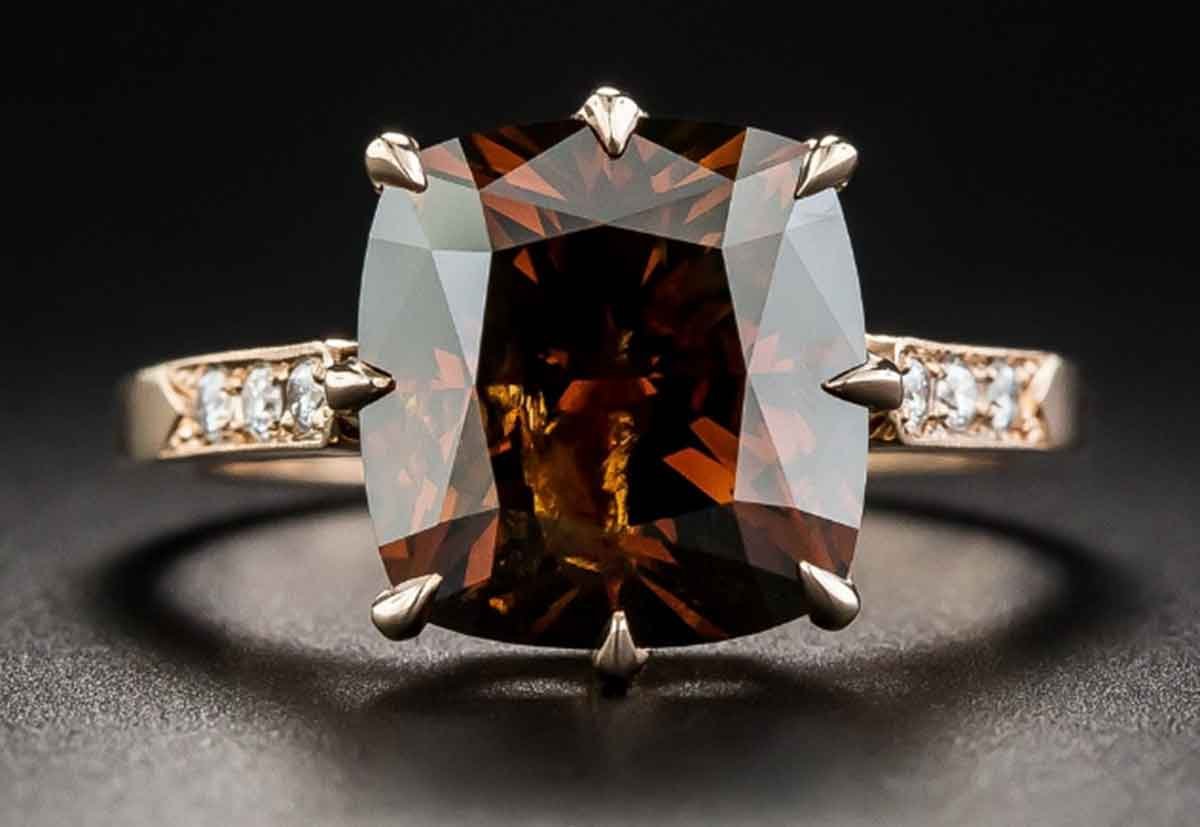
Brown diamond—not the least among its colored cousins
For people with an inclination towards diamond, but don’t quite have the budget for it, the brown diamond is the solution to their woes.
This is the most prestigious of brown stones, sometimes called champagne, chocolate, or cognac.
Brown diamonds are the most common of all colored varieties of natural diamonds. Being such, it is the most affordable of them all. They make excellent center stones for engagement rings. It’s kind of making a statement against traditional colorless diamonds.
And because of its color, inclusions and imperfections are not so obvious to the naked eye. Look for a stone that is eye-clean with no visible impurities.
Aside from being such a classy jewelry piece, it also symbolizes stability, practicality, and dependability.
Chocolate Opal
Opal is a form of silica, chemically similar to quartz with a variable amount of water within its mineral structure. Hence, it is soft.
This stone comes in several color varieties, among them is chocolate opal.
Chocolate opal has a dark body tone, sometimes containing interesting snakeskin-like patterns. It is generally translucent to opaque with a waxy, glossy luster. Some stones may have some small flaws and impurities but they don’t affect their overall value. Of course, the most expensive are those without any trace of imperfection.
Unlike other opal varieties, chocolate opal has a clean and intense flash of color that can display the entire color spectrum. Though they are relatively soft, they can be used for daily wear.
Its softness should not be taken for weakness as this stone possesses powerful and emotive attitudes that induce visions.
Brown Tourmaline
If there is a gemstone that comes in all colors known to man, that would be tourmaline. But its brown variety is hard to come by in most jewelry stores. If you can find one, chances are that it may come with secondary shades like pink or purple. They are generally affordable, but the dark, intensely saturated variety with excellent clarity and brilliance is expensive.
Brown tourmaline is a fiery and brilliant stone and the most durable of all types of jewelry. It is sometimes called dravite—the sodium-magnesium member of the tourmaline family. It is a very strong grounding stone that is believed to raise stamina, life force, and protective energies.
They are mostly faceted to enhance their brilliance and are used mostly on earrings, pendants, and rings where they can give an eye-catching sparkle.
Fire Agate

Like looking through a wall – Fire agate
Fire agate is a variety of chalcedony, a natural gemstone, found only in certain parts of Mexico and the United States.
These stones have beautiful iridescent colors like the ones in this Wolf Badger review, colors similar to opal. High-quality fire agate has a stunning play of colors, a waxy luster, and generally translucent. It is best done for unique designs that highlight its shape and sheen.
Here’s a bit of a warning, though. You cannot find them in regular jewelry shops but in handmade artisan stores or curio shops. They are very hard and notoriously difficult to work with. Though affordable, the workmanship that goes into a finished product makes them expensive.
But some people put in the effort to get one because it is thought to build a protective shield around the body, deflecting harm and hurling it back to its source.
Brown Topaz
The word topaz originated from the Sanskrit word “tapaz,” meaning fire. It is a silicate mineral of aluminum and fluorine. Like tourmaline, it also comes in various colors, but the most important varieties are those within the color range of yellow and brown—mined chiefly in Ouro Preto, Brazil. Brown topaz from this location is often described as “precious” and “imperial.”
Brown topaz is not as sought-after as its blue cousin. But it has its own charm. When faceted into shapes like ovals, trilliants, marquis, round, baguettes, and squares, it catches the light well and it sparkles and looks fiery.
This is a hard gemstone and jewelers find them perfect for all types of jewelry such as rings.
While most brown topaz in the market is free of inclusions, when you want to buy the real one, insist on verification and guarantee the authenticity of the origin of the stone. Many gemstones in the market are labeled “topaz” or any of its variants, but they are not real topaz.
Tiger’s Eye
Tiger’s eye is a mineral composed mainly of silicon dioxide and iron oxide – the mineral that gives it its brownish color. Check out this David Yurman review to see firsthand what it looks like on a jewelry piece.
Its color range is brown to golden brown with intriguing patterns across its surface. Its chief source is the Northern Cape Province, South Africa. Other less important sources are Namibia, Australia, India, and Thailand.
It is called Tiger’s Eye because of its “chatoyancy,” an optical reflectance effect caused by aligned inclusions in the stone. It can be seen on some gemstones, wood, or carbon fibers.
Tiger’s eye is opaque in its natural brown to golden brown color. But some marketers dye them, however, as a marketing ploy.
Other than being a fascinating gemstone, Tiger’s eye has an awesome meaning as well. It helps release your fear and anxiety; aids harmony and balance.
Mahogany Obsidian
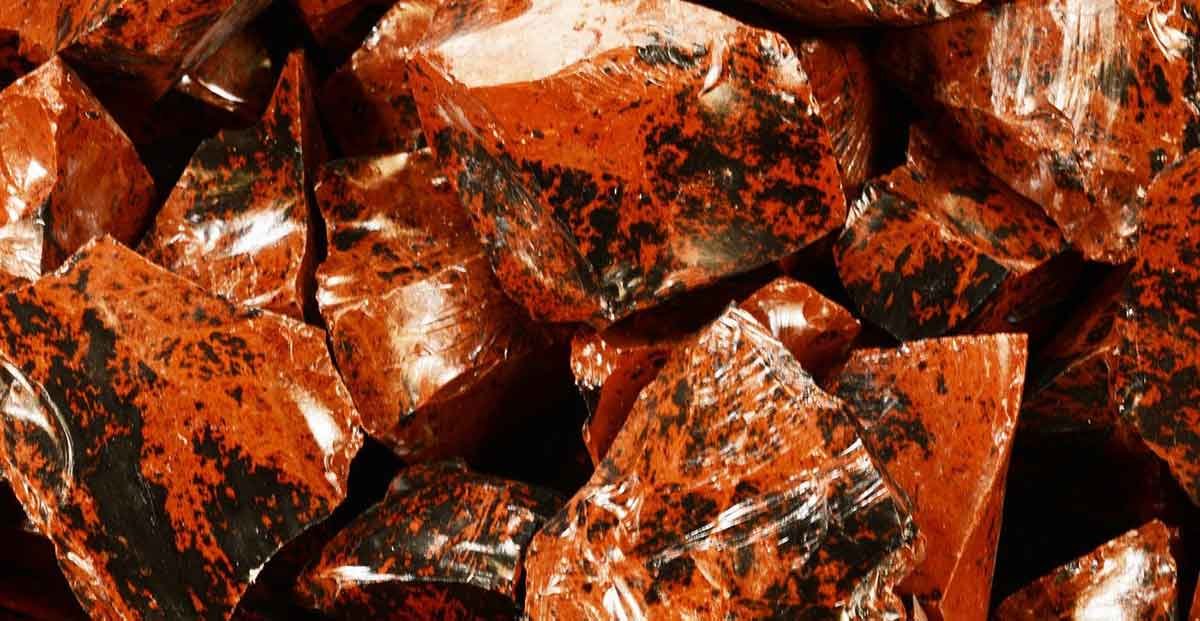
Mahogany obsidian – as fiery as its source
Obsidian is a stone born from fire. It is a volcanic glass formed when felsic (relating to a group of light-colored minerals like feldspar, feldspathoids, quartz, and muscovite) lava cools rapidly with minimal crystal growth.
This gemstone comes in many colors such as tan, green, brown, and black. Sometimes, blue, red, orange, and yellow comes out. Among the colors, black is the most common.
Mahogany obsidian occurs when the lava contains magnetite and hematite inclusions. It is dark brown in color and often comes with beautiful bands of red, brown, and black.
Favorite cuts are cabochons or carved. Because of its excellent earthy vibes, it is often used in bohemian or hippie designs.
Brown Citrine
Brown citrine is one of the most popular gemstones in the citrine family. It is highly transparent with a glassy luster, has good clarity with very few impurities.
This is a fairly common gemstone and finding high-quality brown citrine jewelry is quite easy. It is durable and can be used for a long time—if given the proper jewelry care.
And if you are looking for a gemstone to make a statement, brown citrine is the best. It is affordable and can help you strengthen your self-esteem and positivity. It provides a vibrant flow of energy in and around your body. On the physical side, it helps in improving digestion and endurance.
Andalusite
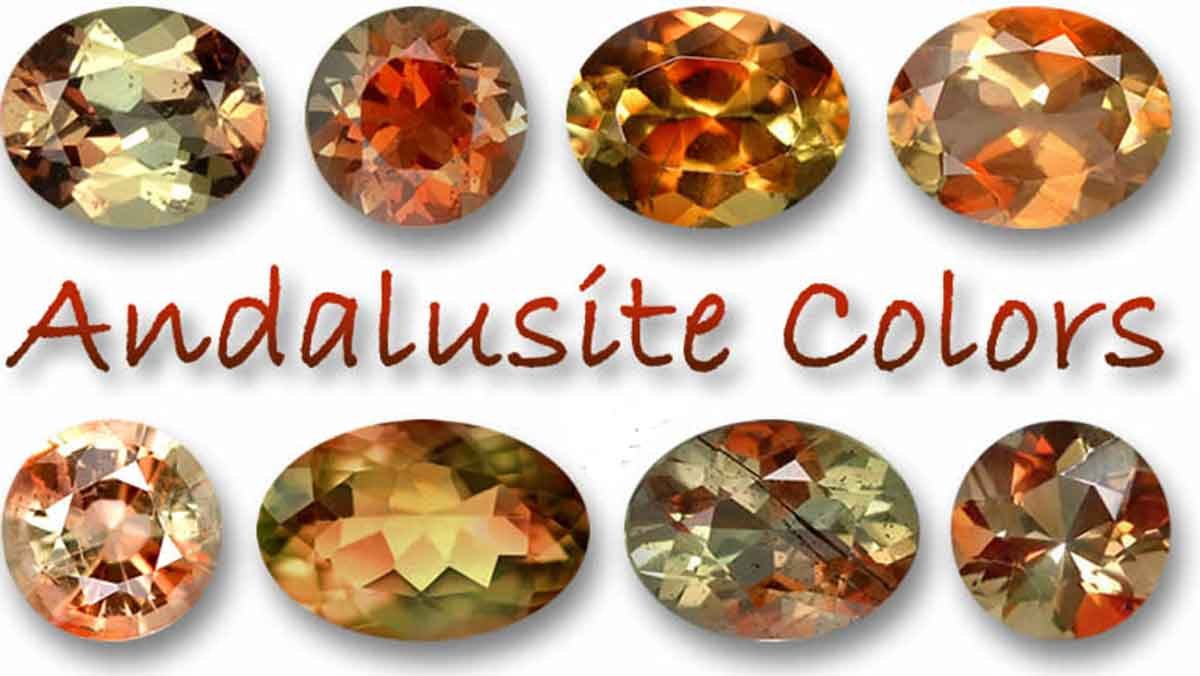
Andalusite color range
Most people are not familiar with this gemstone.
Andalusite is an aluminum-nesosilicate mineral that formed under low pressure and low to high temperatures. It got its name from the inial belief that the sample analyzed came from Andalusia, Spain. Subsequent investigation, however, proved that it came from El Cardoso (Guadalajara). But the name stuck.
Though it comes in a range of brown hues, there are other colors as well, such as greenish, violet, or even colorless. However, it is difficult to see its real color because this gemstone is pleochroic—it changes color when viewed from different directions. Most brown andalusite has secondary colors like yellow, green, or orange.
This stone can be translucent or opaque. There are transparent varieties but they are very rare.
Most andalusite jewelry items are rings, earrings, and pendants where they can show the gem’s brilliance and pleochroism. And they are tough and durable for daily wear.
This is a “seeing” gemstone, meaning it promotes the desire for self-realization; helps one to rebalance and re-align his or her life. It helps the wearer discover problems and emotional blockages and points the wearer to possible solutions.
Smoky Quartz
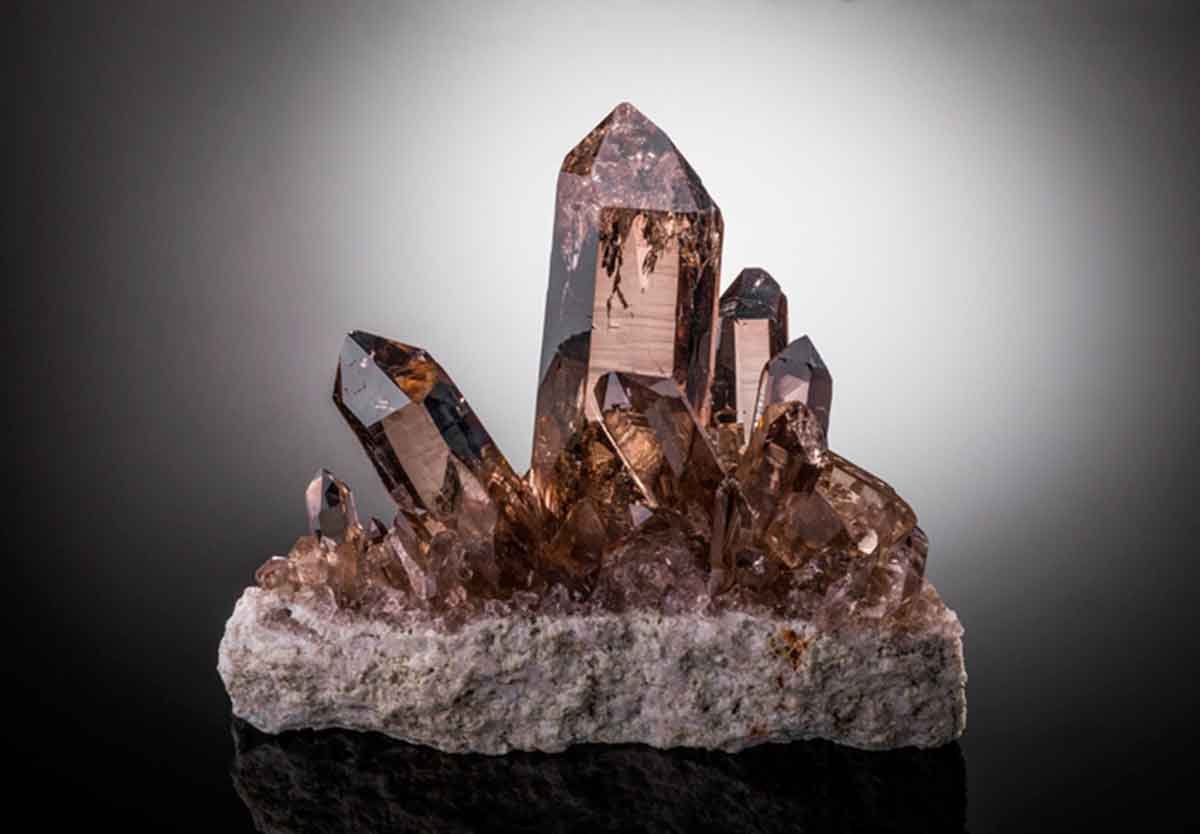
Magnificient even in the rough – Smoky quartz
Smoky quartz is a silicon dioxide crystal with a brownish-gray color. It is the translucent variety of quartz with a clarity that ranges from almost completely transparent to almost opaque, to black.
Brazil is its main source, while Madagascar produces it in commercial quantities. Smoky quartz is the national gem of Scotland. The Scots call it “cairngorm” (after the Cairngorm Mountains).
Smoky quartz is one of the most popular brown gemstones, owing to its being inexpensive and very common. Its color ranges from faint, smoky brown to solid black. Most buyers go for medium to vivid brown.
This gemstone has a vitreous luster, with little to no visible flaws. And because of their abundance, they are perfect for fashion and custom jewelry at affordable prices. Faceted cuts are perfect for smoky quartz to display a good amount of brilliance.
And if you are going through a depressive mood, smoky quartz is best for you. This gemstone disperses fear, banishes depression. It brings emotional calmness, relieves stress and anxiety.
When it comes to gemstones, color is the king. In fact, many customers go for the color first, the gemstone variety second. As long as the jewelry will last long enough, and fits their purpose and budget, they have something to talk about to their friends. However, finding gems by color can be difficult—with all the colors out there.
Brown gemstones have come a long way from practical anonymity to becoming a darling among celebrities—well, sort of. May this article achieve its dual purpose of letting you know what they are and how they can help you make a statement.
Now, if brown is not your color, perhaps you’d like to find out about pink gemstones, for that, you can read our article, “Top Pink Gemstones To Give Your Style A Pop Of Color.”
